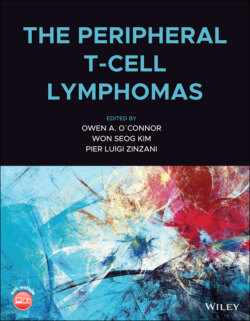Читать книгу The Peripheral T-Cell Lymphomas - Группа авторов - Страница 34
Eosinophils
ОглавлениеBlood and tissue eosinophilia may be seen in various PTCLs as a result of non‐clonal expansion of normal eosinophils mediated by eosinophilopoietic growth factors, such as IL3, granulocyte‐macrophage colony stimulating factor and IL5 normally produced by activated T cells (for review see Roufosse F et al. [89]). Other factors promoting eosinophil chemotaxis include RANTES (regulated on activation normal T cell expressed and secreted)/CCL5 and eotaxins 1–3 (CCL11, CCL24, CCL26). RANTES also exerts chemoattractant activity for T lymphocytes, monocytes, and basophils, and is produced by a variety of cell types, including T cells, fibroblasts, and epithelial cells. Eotaxins signal through CCR3 receptor, which is expressed at high levels on eosinophils and Th2 cells. Cellular sources of eotaxin include fibroblasts, endothelial cells, eosinophils, and lymphocytes.
PTCLs most commonly associated with eosinophilia include primary CTCL, AITL, and ATLL. Approximately 15–20% of patients with mycosis fungoides and up to 75% of those with Sézary syndrome develop blood eosinophilia and show numerous eosinophils within cutaneous lymphoma infiltrates. Eosinophilia in mycosis fungoides and Sézary syndrome, is related to the Th2 nature of the lymphoma cells, which produce IL4, IL5, and IL13. The recruitment of eosinophils to the skin is mediated by chemoattractants produced by the lymphoma cells but also possibly by other cell types. Indeed, IL4‐producing lymphoma cells induce increased expression of eotaxin‐3/CCL26 by keratinocytes, endothelial cells, and fibroblasts [89]. In cutaneous ALCL as well lymphomatoid papulosis (type A), a reactive inflammatory infiltrate may be found within the tumor, and eosinophils may be detected in a substantial proportion of patients occasionally representing the predominant cell type. CD30+ tumor cells isolated from skin biopsies with cutaneous ALCL have been shown to coexpress CCR3 and IL4, and eotaxin in conjunction with surrounding cells, indicating that they contribute to eosinophilic infiltrates [90].
The functional role of eosinophils within the tumor microenvironment remains poorly characterized. Eosinophils also produce IL5 and since they also express the cognate receptor, autocrine activation is possible. Clinical and experimental investigations have shown that eosinophils can function as antigen‐presenting cells and can promote the proliferation of effector T cells. In addition, eosinophils are able to produce an array of cytokines (IL2, IL4, IL6, IL10, and IL12) capable of promoting T‐cell proliferation, activation, and influencing Th1–Th2 polarization, thereby regulating tumor cell growth and expansion [91].
